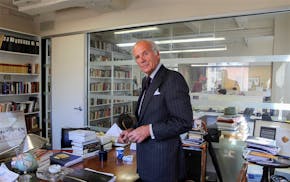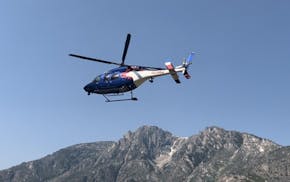Secret Service agent Clint Hill heard the third rifle shot that exploded the back of President John F. Kennedy's skull that November day 50 years ago in Dallas. "It was the sound of something hard hitting something hollow." He had already seen the president grab his throat and lurch to the left, after the first shot.
Using every bit of his strength and with the driver hitting the gas, Hill somehow pulled himself onto the back of the presidential limousine to get to First Lady Jacqueline Kennedy who was at that very moment — in shock — climbing on the trunk toward him. "What is she doing? What is she doing?" he thought. "Good God, she's going to go flying off the back of the car!" He remembered seeing her eyes filled with terror. Then it dawned on him; she was reaching for a piece of her husband's head.
Those horrific moments in Dallas haunted Hill for decades. He struggled with alcohol and depression. The North Dakota boy who grew up to protect one of the world's most glamorous women was in anguish for years, thinking "what if?" What if he had been faster and moved toward the big black Lincoln just a second sooner, after he heard the first shot?
He could have saved the president.
It is only now — after coming to terms with what happened that day, after visiting the crime scene on Elm Street in 1990 and after just last year writing a book, "Mrs. Kennedy and Me," that he has reached some peace — a peace that allowed the 1954 graduate of Concordia College in Moorhead to return to his home state this month to tell his story.
"I think about it every day … There's always something there to remind you," Hill told a crowd of about 600 at Bismarck State College for a Nov. 5 symposium, "The Kennedy Legacy: 50 years later." "It never goes away."
At every twist and turn of those terrible four days — from the assassination to Monday's funeral — Clint Hill was there, all the time wrestling with guilt and fighting back the memories of what he had seen — blood, bone and brain matter splattered everywhere. "She [Jackie] didn't even know I was there," Hill said in Bismarck, 40 miles south of his hometown, Washburn. "I got a hold of her and put her in the back seat. The president fell onto Mrs. Kennedy. I could see that his eyes were fixed."
Hill knew then that the president was dead.
'How badly was he hit, Clint?'
As the agent shielded the two with his body, the limo rushed to Parkland Hospital. In the chaos that ensued at the entrance, the first lady held tightly to her husband. Instinctively, Hill understood that she didn't want anyone to see the president's terrible head wound. "I took off my suit coat and placed it over his head and upper torso," he wrote in his book, and then she released her grip.
When UPI correspondent Merriman Smith — who let the world know of the shooting minutes earlier with the first bulletin at 12:34 CST — ran into Hill at the hospital and asked him, "How badly was he hit, Clint?" Hill replied curtly, "He's dead," Smith wrote in his Nov. 23, 1963, eyewitness account.
Minutes after that exchange, Hill set up a direct phone line in the hospital to Washington and took a call from Attorney General Robert Kennedy. The president's brother asked: "How bad is it?" Hill, not wanting to tell the attorney general that his brother was dead, replied, "It's as bad as it gets."
Throughout the next three days, Hill stayed close by Jackie's side, filling her every request and even providing the scissors so she could cut a lock of her husband's hair as he lay in his casket.
Hill, 81, and his co-author, Lisa McCubbin, have been traveling the country since his book was published in 2012. A second book, "Five Days in November" is being published this month. The guilt is finally gone and, as the person closest to the assassination who is still alive, he has funneled his energy into telling his story for history's sake.
His pain made public on '60 Minutes'
In 1964, Hill received the Treasury Department's highest award for bravery. "I don't deserve an award. The president is dead," he wrote of his thoughts at the time. He fell into a deep depression. "I'd just get up in the morning and drink. I didn't do anything. Friends would come to see me and I wouldn't even respond to them," he said in a recent C-SPAN interview.
In 1975, his anguish went public on CBS' "60 Minutes." The late Mike Wallace asked Hill if there was anything he or other agents could have done to save the president. Hill answered in the third person. "If he [Clint Hill] had reacted about 5-10ths of a second faster. Maybe a second faster, I wouldn't be here today."
Wallace responded: "You mean you would have gotten there and you would have taken the shot?"
Hill: "The third shot, yes sir."
Wallace: "And that would have been all right with you?"
Hill: "That would have been fine with me."
Wallace, in his book "Close Encounters," wrote: "I have never interviewed a more stricken and tormented man. Hill's anguish was so acute, so visceral that I had to fight back the tears that were welling up inside of me."
It was after that interview that Hill began his long, slow climb. In a letter to Wallace, he wrote: "My interview with you on "60 Minutes" in 1975 turned into much more of an emotional experience than I thought possible. I did not realize that I was in as much emotional distress as I obviously was. It did turn out to be a cathartic experience for me, and helped me release feelings that had been pent up in me for a long time."
Another healing step was a 1990 trip with his wife to Dallas. He walked Dealy Plaza for about two hours. He looked at every angle, every possibility and "let everything run through my mind that I could think of that happened that day. And I finally came to the realization that I did the best I could do. That I really didn't have a chance of doing anything other than what I did do."
In Bismarck, Hill was asked how he dealt with the exhaustion and incredible stress of that November weekend.
"Emotionally, it was extremely difficult. And I just put it out of my mind and kept my focus on what had to be done that day." But he finished with a telling comment: "We really didn't have time to think about our own grief. We never received any counseling and we never discussed it."
And he was asked — as he often is — about conspiracy theories and whether assassin Lee Harvey Oswald acted alone.
He answered emphatically: "There were only three shots that were fired on Nov. 22, 1963. Only three. They all came from the same location: The sixth floor window of the Texas School Book Depository. They were all fired from the same rifle. That rifle was fired by one individual who acted alone and his name was Lee Harvey Oswald."
Pamela Huey • 612-673-7044

JD Vance, an unlikely friendship and why it ended

Lewis Lapham, editor who revived Harper's magazine, dies at 89

Body of missing Minnesota hiker recovered in Beartooth Mountains of Montana
Mike Lindell and the other voting machine conspiracy theorists are still at it
